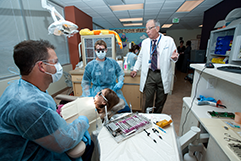Doctor of Dental Medicine (DMD) program
The DMD designation indicates the degree awarded upon graduation from dental school to become a general dentist. Harvard was the first dental school to award the DMD.
According to the American Dental Association (ADA): “There is no difference between the two degrees; dentists who have a DMD or DDS have the same education. Universities have the prerogative to determine what degree is awarded. Both degrees use the same curriculum requirements set by the American Dental Association’s Commission on Dental Accreditation. Generally, three or more years of undergraduate education plus four years of dental school is required to graduate and become a general dentist. State licensing boards accept either degree as equivalent, and both degrees allow licensed individuals to practice the same scope of general dentistry. Additional post-graduate training is required to become a dental specialist, such as an orthodontist, periodontist or oral and maxillofacial surgeon.”
Student testimonials
ATSU-ASDOH program competencies
A.T. Still University’s Arizona School of Dentistry & Oral Health (ATSU-ASDOH) uses the following 30 competencies to measure student progress throughout the program. Upon graduation, those granted the DMD will be able to:
Domain I: Foundation knowledge and information literacy
- Understand and apply foundational knowledge: Ability to understand and apply the foundational principles of biomedical, behavioral, and clinical sciences in the delivery of patient care.
- Evidence-based practice: Evaluate and integrate best research outcomes with clinical expertise and patient values for evidence-based practice.
- Lifelong learning: Demonstration of professional values and capacities associated with self-directed, life-long learning ability, including the ability to self-assess learning needs.
Domain II: Clinical patient care
Manage the oral health care of patients in all stages of life, as well as the unique needs of patients with special needs.
Patient management
- Communication: Apply appropriate interpersonal and communication skills, including working with diverse populations.
- Behavioral management: Apply psychosocial and behavioral principles in patient-centered health care.
Critical thinking and problem solving
- Critical thinking and problem solving: Utilize critical thinking and problem solving skills in the delivery of patient care.
Clinical technique and skills – Patient assessment, diagnosis, and treatment planning
- Patient assessment: Select, obtain, and interpret patient/medical data and diagnostic images; identify and assess patient factors including socioeconomic and behavioral; and use these findings to accurately assess and manage all patients. Patient assessment includes the ability to recognize patient abuse and/or neglect, substance abuse, and the ability to screen and provide risk assessment for oral cancer.
- Diagnosis: Formulate a comprehensive diagnosis that recognizes the manifestations of systemic disease and how the disease and its management may affect the delivery of dental care.
- Treatment planning: Formulate comprehensive treatment plans, including alternatives, with benefits, risks, and prognosis for the management of patients. Treatment planning includes the ability to recognize the complexity of patient treatment and identifying when referral is indicated.
Clinical techniques and skills – Establishment and maintenance of oral health
- Pain and anxiety control: Prevent, diagnose, and manage pain and anxiety in the dental patient.
- Restoration of teeth: Manage restorative procedures that preserve tooth structure, replace missing or defective tooth structure, maintain function, are esthetic, and promote soft and hard tissue health.
- Replacement of teeth: Manage the replacement of teeth for the partially or completely edentulous patient, including fixed, removable, and dental implant prosthodontic therapies, and communicating and managing laboratory procedures in support of patient care.
- Periodontal therapy: Prevent, diagnose, and manage periodontal diseases.
- Pulpal therapy: Diagnose, identify, and manage pulpal and periradicular diseases.
- Oral mucosal and osseous disorders: Diagnose, identify, and manage oral mucosal and osseous diseases.
- Hard and soft tissue surgery: Diagnose and manage oral surgical treatment needs.
- Medical and dental emergencies: Prevent, recognize, and manage medical and dental emergencies.
- Malocclusion and space management: Diagnose and manage developmental or acquired dentoalveolar, growth-related, and occlusal abnormalities.
- Pharmacotherapeutics: Apply and/or prescribe appropriate pharmaceutical agents to support treatment.
- Evaluate outcomes of comprehensive dental care for patients.
Self-assessment
- Self-assessment: Ability to self-assess the quality of care provided, and identify learning needs to enhance professional knowledge, skills and values.
Domain III: Professionalism and leadership
- Ethics: Application of ethical principles and ethical decision making in the provision of care.
- Jurisprudence and risk management: Apply legal standards and regulatory concepts related to the provision of health care services, including appropriate record keeping and informed consent.
Social responsibility
- Leadership and professional role modeling: Function successfully as leader of the oral health team and demonstrate capability to serve as a professional role model in the community.
- Access to care for at-risk populations: Recognize and appreciate the need to contribute to the improvement of oral health beyond those served in traditional practice settings.
- Community health promotion and prevention: Participate with dental team members and other health care professionals to provide prevention, intervention, and educational strategies for individuals, families, and groups in the community.
Intra- and interprofessional communication
- Intra- and interprofessional communication: Ability to communicate and collaborate with other members of the health care team in a multicultural work environment to facilitate the provision of care.
Healthcare delivery systems
- Practice management: Evaluate and apply contemporary, innovative, and emerging practice management principles including business, financial management, and technology resources for the dental practice.
- Healthcare delivery models: Evaluate and manage current models of oral health care management and delivery systems.
- Outcomes and quality improvement: Evaluate outcomes of treatment and apply quality improvement concepts to delivery systems.
Certificate in public health
In addition to earning DMD degree, all ASDOH students earn a certificate in public health core concepts, taking the following courses (*):
*Subject to change
- Introduction to Dental Public Health
- Behavior Science and Educational Concepts
- Dental Epidemiology
- Dental Healthcare Policy and Management
- Financing Dental Care
The first course in the certificate program is taken at the beginning of the second semester in the first year. Courses are quarter-based and offered online in 10-week sessions through ATSU’s College of Graduate Health Studies. Students who wish to complete a master’s degree in public health need to take 10 additional courses, (in addition to the 5 noted above for the certificate) for a total of 15 courses. These courses, in addition to the dental school curriculum, provide students with a broad exposure to public health and program planning, equipping students for service to underserved populations and community-based learning in the fourth year.

